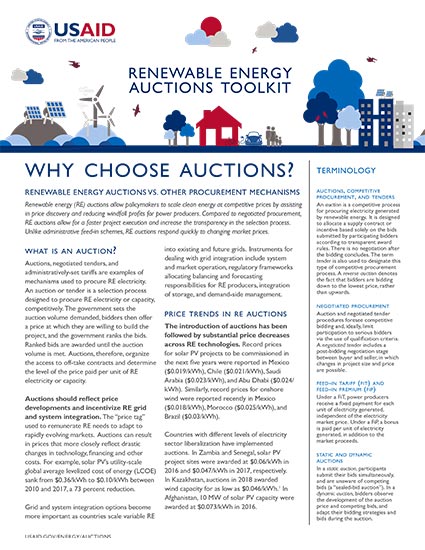- Energy Home
- How We Work
- Programs & Initiatives
- EmPOWERing Women and Girls
- Competitive Energy Procurement
- Auctions Toolkit
- Introduction
- Design
- Renewable Energy Integration
- Training
- Country Experience
- Resources
- Why Auctions?
- Designing RE Auctions
- Stages of Design
- Design Process
- Prequalification & Ceiling Prices
- Financial Guarantees & Penalties
- System-friendly Procurement
- Technology Selection
- Variable RE Forecasting
- Impact on System Operations
- System-friendly Procurement in Bangladesh
- Variable RE in Bangladesh
- Auctions Toolkit
- Toolkits
- Monitoring & Evaluation
- Resources
- Stories
Speeches Shim
Renewable Energy Auctions Versus Other Procurement Mechanisms
Renewable energy auctions allow policymakers to procure clean energy at competitive prices by assisting in price discovery and reducing windfall profits for power producers.
An auction is a competitive process for policymakers to procure electricity generated by renewable energy. Policymakers can hold auctions regardless of market maturity and institutional capacities and can choose different entities to conduct auctions. An auctioneer can be an energy regulator, electricity market operator, or dedicated agency. The auctioneer issues a tender with clear rules in an online or other public platform, which ensures a transparent and competitive procurement process.
When used strategically, auctions can facilitate competitive renewable energy price setting, lower costs, expand access to affordable and sustainable energy, and increase transparency of energy procurement.
Auctions, negotiated procurements, and administrative feed-in mechanisms are the three most prevalent price-setting methods for procuring electricity from renewable energy.
Auctions are the emerging best practice and are achieving historically low prices globally while promoting private investment in renewable energy for sustainable development gains. Compared to negotiated procurement, auctions allow for faster project execution and increase transparency in the selection process. Unlike administrative feed-in mechanisms, auctions respond quickly to changing market prices.
About Renewable Energy Procurement Options
Auctions are a competitive process for procuring electricity generated by renewable energy. The government sets the auction volume demanded, bidders then offer a price at which they are willing to build the project, and the government ranks the bids. Ranked bids are awarded until the auction volume is met. Therefore, auctions organize the access to off-take contracts and determine the level of the price paid per unit of renewable energy electricity or capacity. There is no negotiation after the bidding concludes.
Negotiated procurements employ competitive bidding and, ideally, limit participation to serious bidders via the use of qualification criteria. A negotiated procurement includes a post-bidding negotiation stage between buyer and seller in which changes in project size and price are possible.
Feed-in mechanisms, such as feed-in tariffs and feed-in premiums, can be used to pay for renewable electricity. Under feed-in tariffs, power producers receive a fixed payment for each unit of electricity generated, independent of the electricity market price. Under a feed-in premium, a bonus is paid, in addition to the market proceeds, per unit of electricity generated.



Comment
Make a general inquiry or suggest an improvement.